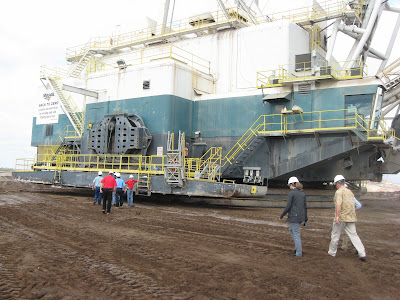Recently, I was invited to a Mosaic Ag Forum in Tampa Bay,
Florida. You may already know that
Mosaic is a main producer of the fertilizer we buy. We spent time going over some of the new
products they are offering and then toured their mining facilities near Bartow,
Florida. Below are some photos and
videos of the "Four Corners Mine" operation as well as some interesting facts.
Of Mosaic's 6 drag lines, this beast is the largest. Weighing in at 7.1 million pounds it runs on 7200 volts of electricity costing roughly $4.5/month to power. Mosaic produces 25% of their electrical needs as a byproduct of Sulfur production. This pure electric motor creates 20,000 horsepower. Replacing this machine today would cost about $110,000,000.
Here you see the process of slurrying the phosphate, clay, and sand for transportation. These robotic water jets are run by one operator and blast out 150,000 gallons/minute.
This is the buckets from the drag line. It weighs about 80,000 pounds. When the base is rotating the bucket at full extension, it is moving approximately 90 miles/hour. This year, it should produce a record 8 million tons of phosphate by moving 130 million tons of soil. That's 5,200,000,000 50# bags of soil.
Here is a closeup of the drag line. You can see a platform with a ladder to the ground. This platform (and it's twin on the opposite side) are used to "walk" the drag line. The platforms are lifted and moved ahead, then the "body" is lifted and moved ahead until their new destination is reached.
This is Jeff Brees, Paul Miller and I standing inside the mouth of an old retired bucket. It gives a pretty good reference of just how big the drag line is.
75% of the phosphate sold in the US and 25% of the World supply comes from Florida. Mosaic owns 322,000 acres in Florida and is capable of producing 17.5 million tons of phosphate per year!
































